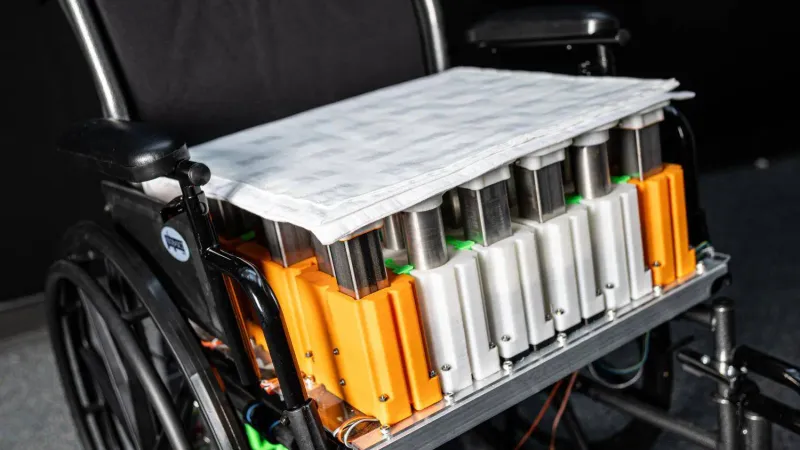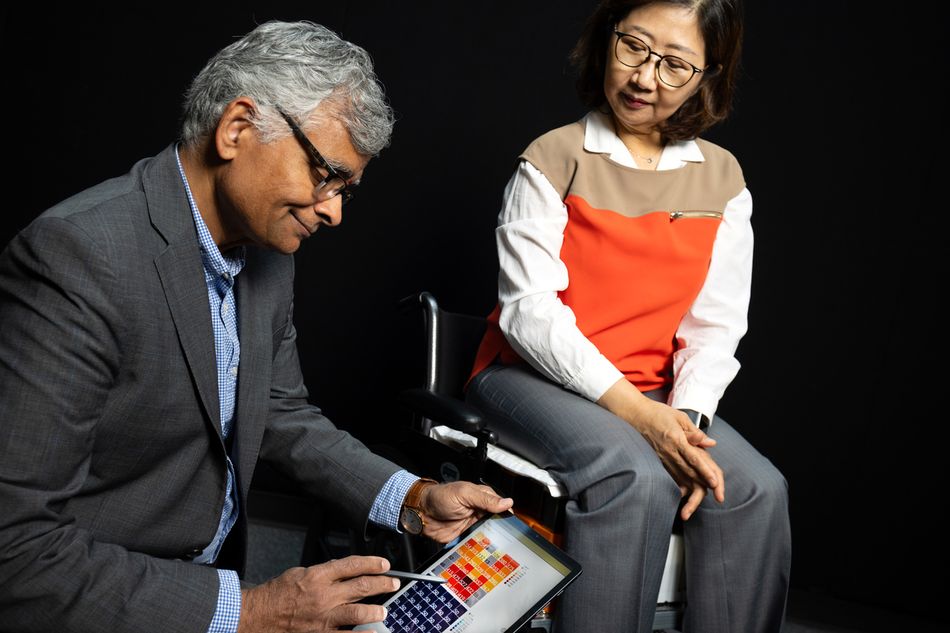Sensor Fabric, Big Data Could Help End Pressure Injuries for Wheelchair Users
MSE researchers are using a Catalyst Award from the National Academy of Medicine to develop a pressure-relieving sensor system that could also be used in hospital beds.

A customized wheelchair system — including fabric sensors, actuators, and fans — designed to prevent pressure injuries. (Photo: Candler Hobbs)
This article was first published on
coe.gatech.eduAt least half of veterans with spinal cord injuries will develop sores on their skin from the unrelieved pressure of sitting for long periods of time in a wheelchair. It’s a constant worry, because these skin ulcers can greatly limit patients’ mobility.
“Pressure injuries directly impact the veteran’s quality of life, because the medical provider will order the veteran to bed rest for weeks and potentially months,” said Kim House, a physician and medical director of the Spinal Cord Injury Clinic at the Atlanta Veterans Administration Healthcare System. “At every clinic visit, I provide education for pressure injury prevention.”
House could one day have a new tool to offer her patients, thanks to researchers in the Georgia Tech College of Engineering, and wheelchair-bound veterans are just the beginning.
Materials engineers are developing new fabric sensors and a customized wheelchair system that assesses and automatically eases pressure at contact points to prevent injuries from developing in the first place.
“We have three key issues happening: First, continuous pressure. Second, moisture, because when you're sitting in the same spot, you tend to sweat and generate moisture. And third is shear. When you try to move somebody, the skin shears. That perfect combination is what causes pressure injuries,” said Sundaresan Jayaraman, professor in the School of Materials Science and Engineering (MSE). “We believe we have a solution to the perfect storm of pressure, moisture and shear, which means the user’s quality of life is going to get better.”
With Principal Research Scientist Sungmee Park, Jayaraman has designed fabric with a network of embedded sensors that covers the seat of a wheelchair. Conductive material is woven into the textile, and it’s washable without degrading the sensors.
Data about pressure and moisture from the sensors feeds into a processing unit that uses artificial intelligence algorithms to identify trouble spots in real time and selectively raise or lower a series of actuators under the wheelchair seat to relieve pressure. That has the advantage of eliminating any shearing forces on the skin that come from sliding against the seat.
Meanwhile, a series of fans activates to eliminate moisture. A companion smartphone app developed in the lab allows users to override the system to maintain comfort and stability — particularly important for people with spinal cord injuries who may not be able to correct their body position on their own.
“Each person moves differently. This system gathers all the pressure and moisture data and also accounts for different body compositions, styles, and weights,” Park said. “We feed all of that big data into the AI algorithms so each person can have an intervention system that works independently. It would be a totally automatic system.”
The team’s idea has advanced in a National Academy of Medicine healthy longevity competition, receiving one of 20 Catalyst Awards out of more than 500 ideas. For House, who earned a bachelor’s in mechanical engineering at Tech in 1995, the potential is powerful: “A wheelchair system that will assist veterans in decreasing risk for pressure injury will allow veterans to become less dependent on caregivers for pressure reduction strategies and allow for increased independence and self-determination.”
Park and Jayaraman will work over the next year to “ruggedize” their system for real-world use. They’re hoping to work with House to collect feedback and ideas from wheelchair users with spinal cord injuries to improve their design.
“With interactive input from users, we can intervene or modify if we need to and improve the prototype so we can move toward actual clinical testing for commercialization,” Park said.
The researchers are focused initially on wheelchairs, but they see larger possibilities for their system. Hospital-acquired pressure injuries cost U.S. hospitals more than $26 billion a year, by some estimates. Avoiding them requires vigilance from medical staff, who must regularly help patients shift their position in bed. The sensor fabric could be deployed on hospital beds or in neonatal intensive care units to cue staff when a patient needs to be moved to relieve a buildup of pressure and moisture.
Eventually, the ideas behind the system even could be extended to help office workers, software developers, or gamers who sit for long periods of time. Data from the sensor fabric might trigger reminders that encourage them to get up and counteract the negative health effects of too much sitting.
“The theme of our work always has been, what can we do as engineers — by being innovative and creative, by bringing engineering problem-solving — to make an impact on society and people’s lives?” Jayaraman said. “We look forward to the day where this technology becomes a reality and people in wheelchairs don’t have to worry — and pressure injuries really become a scourge of the past.”
